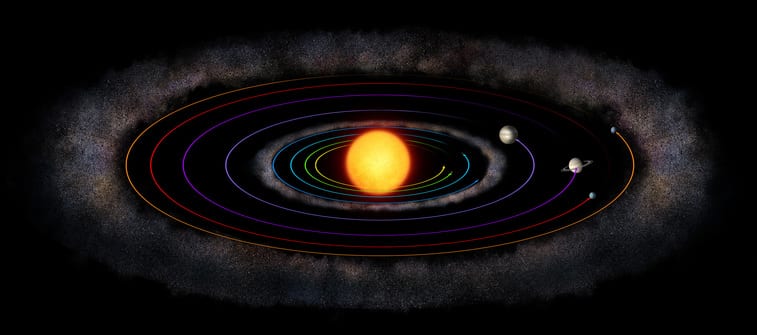Sample Lesson—Bring Science Alive! Earth Science
Each unit begins with a storyline that allows students to dive deep into a real-world phenomenon. The Anchoring Phenomenon encourages students to make connections with the world around them. Students then further explore the phenomenon during the Performance Assessment.
Storyline: Learn about gravity’s role in the formation of the solar system, the growth of planets in the solar system, the existence of stars beyond our solar system, and the structure of the Milky Way and other galaxies. As a consultant, help a movie director shooting a film about space to make sure the end product accurately reflects the laws of physics and space.
Anchoring Phenomenon: Celestial objects in our solar system and beyond all follow distinct patterns of movement.
After student watches the anchoring phenomenon video, students begin a KWL chart in the Unit Checkpoints. They generate questions for inquiry and return to answer questions charts throughout the unit.
| View it in print | View it online |

Each lesson begins with an investigative phenomenon that is used to pique students’ interest and drive instruction throughout the investigation.
Lesson 8 Phenomenon: Humans weren’t around to watch the solar system form, but we have observed patterns that may explain its formation.
By the end of the lesson, students will be able to explain the phenomenon.
 |
 |
| View it in print (p.1-2) | View it online |
Hands-on investigations allow students to take on the role of scientists and explore real-world problems. Students work in the Science and Engineering Practices by asking questions and defining problems, constructing explanations and designing solutions, and developing and using models. Students interact with the Crosscutting Concepts including Scale, Proportion, and Quantity, and Systems and System Models. Disciplinary Core Ideas are also embedded within the investigations.
In Lesson 8: Formation of the Solar System, students model gravity’s role in the formation of the solar system and evaluate videos of solar system formation for pattern consistency.
Investigation 1: Modeling Gravitational Force |
| View it in print (p.4-16) | View it online |
The Reference Text features considerate and engaging text with engineering content built right in. On TCI’s learning online platform, the Reference Text offers Text-to-Audio, Main Idea Viewer, Spanish translation, Student Highlighter Tool, and more. In addition, resources beyond the text are embedded in TCI’s online learning platform. This includes Check for Understanding, digital simulations, and videos that will help students investigate phenomena more meaningfully.
Explore lesson 8’s print and online Reference Text where students learn about the formation of the Solar System.
| View it in print (p.128-139) | View it online |

Each lesson includes a TCI assessment that addresses all three dimensions, uses diverse stimuli, and allows students to express understanding in multiple formats. You can use it as a formative or summative assessment to evaluate students’ ability to explain real-world data and phenomena. Want more flexibility with assessments? You can also create your own, or use shared questions from other TCI teachers.
| View in Print | View it online |
 Engineering
Engineering|
Throughout the program, students participate in Engineering Challenges where they think like an engineer as they solve real-world problems related to unit anchoring phenomenon. They go through the engineering design process for each challenge. In Unit 3: The Solar System and Beyond, students design and test a “space capsule” that will protect a camera from being smashed upon its return from space. |
| View it in print | View it online |

|
Reading Furthers are included in each lesson to enhance literacy and engage students with related topics. Students dive into a high-interest topic and investigate the intricacies of science. In lesson 8’s Reading Further, students read about scientists’ hunt for meteorites in Antarctica to learn about the secrets of the Solar System.
|

Students apply what they have learned in a hands-on Performance Assessment where they are evaluated across the three dimensions.
Unit 3 Performance Assessment: Writing a Gravity Adventure Scene
Write a script for a movie’s climax using a gravitationally correct scenario. The script will present an exciting drama that results from gravity’s force on celestial objects, and then you’ll explain exactly how gravity is responsible for the event.
 |
 |
| View it in print | View it online |